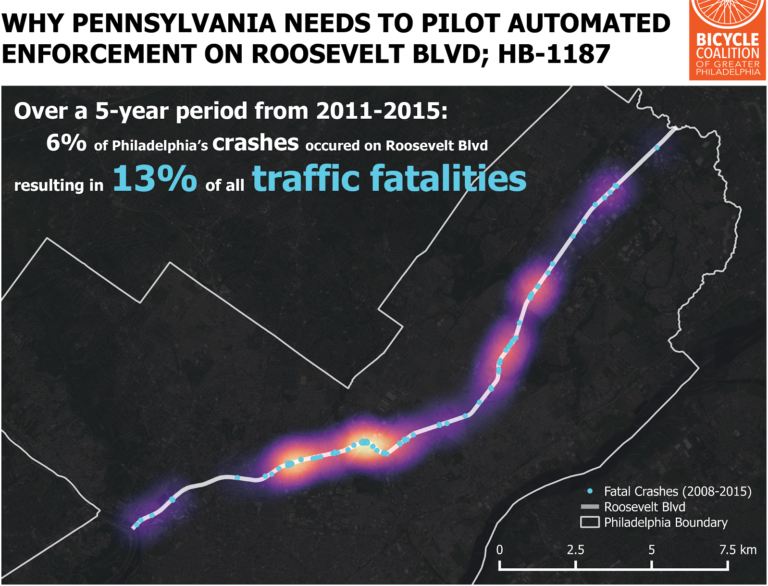
The state Legislature’s current session is coming to an end, and the Philadelphia Vision Zero Alliance has been working on getting several bills passed before our state representatives and senators recess for their summer vacation.
There are numerous bills in the Legislature we need to see passed this year. They would allow: automated speed enforcement in work zones and on Roosevelt Boulevard to cut down on illegal speeding; PennDOT to install parked car protected bike lanes; further restrict distracted driving caused by cell phone use; prioritize vulnerable users; and allow municipalities to use radar for local law enforcement.
The Bicycle Coalition and volunteers are heading to Harrisburg on May 1 to hold a press conference and meet with legislators on this issue. Click here to join us in Harrisburg on that trip.
We’ve detailed these bills below. If you’re interested in sending a message to the state’s leadership, asking them to bring these bills up for a vote, click here now.
Speed cameras pilot in work zones and speed cameras pilot on Roosevelt Boulevard- SB 172
Earlier this year, the National Transportation Safety Board recommended that states and localities take stronger action to address speeding, which is responsible for the same number of traffic deaths as drunk driving nationwide. Among those recommendations: all states without auto enforcement programs, such as Pennsylvania, should pass authorizing legislation.
The place to start is on Roosevelt Boulevard. This 15-mile stretch of roadway makes up only 0.6 percent of Philadelphia’s streets, but is where 13 percent of the City’s traffic deaths occur annually.
This bill would also allow provide a five-year trial period for PennDOT to place speed cameras in active work zones on limited access highways.
Painted Curbs/Protected Bike Lanes – SB788
Current Vehicle Code language prevents the construction of certain types of Parking Protected Bike lanes as in this design, vehicles are not able to meet the requirements of the law being five or more feet from the curb.
“[E]very vehicle standing or parked upon a two-way highway shall be positioned parallel to and with the right-hand wheels within 12 inches of the right-hand curb or, in the absence of a curb, as close as practicable to the right edge of the right-hand shoulder.”
As a solution to this problem, legislation was drafted to require parked vehicles to be within 12 inches of the outside line of the buffer area between the pedalcycle lane.
Cell phone ban for novice drivers – SB 786
This bill creates a cell phone ban for novice drivers (under 18 years of age or a person with a learner’s permit) from using a cell phone.
Radar for Local Law Enforcement – SB 251
This bill would allow municipalities (after adopting an ordinance) to use radar technology to monitor traffic speed. The bill caps the amount of revenue a municipality can retain and sets calibration standards for RADAR guns.
It is supported the Coalition to Eliminate the Prohibition Against Municipal Police Using Radar.
Cell phone ban – HB 1684
This bill, introduced by Representative Rosemary Brown prohibits those older than 18 to talk on cell phones without hands-free accessories, prohibits those under 18 from using a cell phone at all, and adds three points to the $50 penalty for violating the law.
Prioritize Vulnerable Users – HB 1646
Earlier this year, Reps. Brett R. Miller and John Taylor introduced HB1646, the “Vulnerable Highway User Protections” bill, to increase the penalties for careless drivers who inflict bodily injury, or worse, death, upon others. Today, a careless driver who kills a pedestrian is fined $500; who causes serious bodily injury – $250.
Vulnerable users, according to the bill’s language, are defined as pedestrians, bicyclists, people in wheelchairs, motorcyclists, skateboarders, horseback riders, horse and carriages and farm equipment. Introduced in July, the bill raises fines for people whose careless driving results in death or bodily harm.
Help us advocate for these bills by sending a message to the Legislature’s leadership.

Senator Tony Williams introduced SB359 in February, 2017. This legislation would allow the amber alert system to be used when there has been a hit and run incident that resulted in serious injury or death.
We have so many motorists’ hit and runs that involve bicyclists and pedestrians. Bike Colorado supported similar legislation in their state and it became law.
I think that this should be a bill that advocacy groups should support and ask Law & Justice Chairman Chuck McIlhinney to have the bill considered in his Committee.
As the Green Party candidate for Pennsylania Governor, and a member of the Coalition, I support this legislation and any legislation which expands safe bicycling, transit, and walking, while reducing dependence on the automobile. I’ve relied on a bicycle for 65 years and do not own a car. http://facebook.com/glover5governor